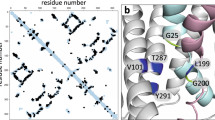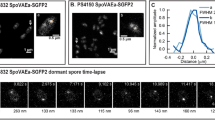Abstract.
Despite being relatively insensitive to environmental insult, the spore is responsive to low concentrations of chemical germinants, which induce germination. The process of bacterial spore germination involves membrane permeability changes, ion fluxes and the activation of enzymes that degrade the outer layers of the spore. A number of components in the spore that are required for the germination response have been identified, including a spore-specific family of receptor proteins (the GerA family), an ion transporter and cortex lytic enzymes. The germinant traverses the outer layers of the spore and interacts with its receptor in the inner membrane to initiate the cascade of germination events, but the molecular details of this signal transduction process remain to be identified.
Similar content being viewed by others
Author information
Authors and Affiliations
Additional information
Rights and permissions
About this article
Cite this article
Moir, A., Corfe, B. & Behravan, J. Spore germination. CMLS, Cell. Mol. Life Sci. 59, 403–409 (2002). https://doi.org/10.1007/s00018-002-8432-8
Issue Date:
DOI: https://doi.org/10.1007/s00018-002-8432-8




